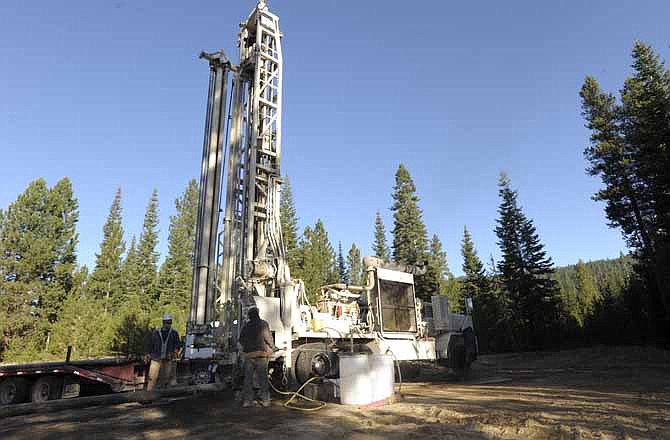GRANTS PASS, Ore. (AP) - Geothermal energy developers working on the flanks of an ancient Oregon volcano say they have taken an important technological step toward expanding geothermal energy from a small niche into a potential major source of homegrown power, but more work needs to be done.
AltaRock Energy, Inc., of Seattle, says the data is still being analyzed, but they are confident they have created three geothermal reservoirs from a single well where none existed before. The breakthrough solves two problems holding back the next level of geothermal development, known as Enhanced Geothermal Systems, or EGS: creating reservoirs big enough for commercial production in places they don't occur naturally, and holding down costs.
The project is at Newberry Crater, the remains of an ancient volcano in central Oregon's Cascade Range. The site has plenty of heat in rocks deep below the surface to boil water into steam, but none of the cracks and fissures in the rock needed to serve as a steam reservoir for a geothermal power plant.
Last fall, engineers pumped cold water into the ground, cracking open fissures in the deep rock, a process known as hydroshearing. They then sealed one reservoir from the other using a new technology. They injected ground-up recycled plastic bottles, which plugged up the cracks in one reservoir while millions of gallons of cold water were being pumped in to create another. Then the plastic diffused, leaving behind three reservoirs.
Company president Susan Petty said in an email that more analysis and testing are needed to show if the reservoirs are good enough for commercial power production in the future - which would be achieved by using steam from the reservoirs to spin turbines to generate electricity.
The U.S. Department of Energy, which is covering half the $43.8 million cost of the Newberry project, says if the initial indications hold up, the Newberry project would mark the first time in the world that multiple geothermal reservoirs have been created on purpose from a single well in a new area.
"So far, things are looking really exciting," said Lauren Boyd, acting team leader for enhanced geothermal systems at Energy.
Heat in the Earth's crust has been used to generate power for more than a century. Hot water or steam that bubbles near the surface is tapped to spin turbines that create electricity. Most of the obvious areas where the three key elements come together - hot rocks, cracks in the rocks, and water - have been exploited. The new frontier is places with hot rocks, but no cracks in the rocks to deliver the steam. That's where EGS comes in. It creates the cracks in the rocks.
Creating multiple reservoirs from a single well is key to making EGS economical, because drilling each well is so expensive, said Nicholas C. Davatzes, assistant professor of earth and environmental science at Temple University, who helped develop a computer model describing the structure of the rock before it was fractured.
"The big impact Newberry has right now is that they appear to have stimulated multiple distinct zones," he said.
Hydroshearing is similar to the process known as hydraulic fracturing, used to free natural gas from shale formations. But fracking uses chemical-laden fluids, and creates huge fractures, too big for geothermal power.
In another recent EGS breakthrough, Calpine Corp. connected two depleted wells to create a new source of power at the nation's largest natural steam resource, the Geysers in Northern California, Boyd said. Multiple reservoirs have also been created from one well by accident in Europe.
The Newberry project followed a new international protocol designed to avoid the kinds of induced earthquakes that shut down an EGS project in downtown Basel, Switzerland. AltaRock reported that seismic monitoring showed tiny tremors so small that instruments registered a larger impact from an earthquake in Japan
Still to come at Newberry is drilling one or two production wells to show whether these reservoirs can provide enough steam to run a commercial geothermal power plant.
"If we can demonstrate that we can create a geothermal reservoir here, then we can have more confidence in our ability to move to similar locations, maybe near other Cascades volcanoes," Petty said.
The Newberry project is one of 230 funded by Department of Energy to create a pathway for private industry to develop geothermal energy into a major source of homegrown power, said Doug Hollette, program manager for the Geothermal Technologies Office at Energy.
The effort is similar to one started by the department in the 1970s, which is now bearing fruit with cheap natural gas from shale deposits, he said.
Commercial production with EGS is still a long way off, because it depends on developing new technologies, he said. In the near term, the department is developing maps of potential new areas to develop conventional geothermal power, including areas that show no signs on the surface. They are expected to be ready in a few years. In the medium term, the DOE is financing development of low-temperature geothermal, and tapping abandoned oil and gas wells for their heat, known as coproduction. Other projects involve adopting horizontal drilling techniques, now common in oil and gas, to connect multiple geothermal reservoirs in a field.
There are 3.2 gigawatts of geothermal power connected to the U.S. grid, less than 1 percent of the grid's capacity. Government estimates put the potential for new discoveries of conventional geothermal power at about 30 gigawatts, and EGS at more than 100 gigawatts over the next 50 years. That would be 10 percent of the grid's current capacity.
"We are big believers that EGS will be a successful part of the energy mix once we show the pathway," Hollette said.

